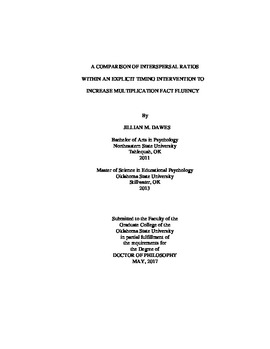| dc.contributor.advisor | Duhon, Gary J. | |
| dc.contributor.author | Dawes, Jillian Marie | |
| dc.date.accessioned | 2018-06-25T13:38:19Z | |
| dc.date.available | 2018-06-25T13:38:19Z | |
| dc.date.issued | 2017-05 | |
| dc.identifier.uri | https://hdl.handle.net/11244/300235 | |
| dc.description.abstract | Interspersal has been examined in the literature as a means to modify interventions and homework assignments by providing theorized reinforcement for the completion of easier problems interspersed into more difficult problems. The current study aimed to examine if any of the included interspersal ratios were more effective at increasing multiplication fact fluency than a no interspersal condition, as well as which interspersal ratio was the most effective. Participants included 62 fourth grade students in general education placements. Participants were placed, using stratified randomization, into one of the four groups: 0 %, 10 %, 20 %, and 40 % interspersal ratios. All participants received four minutes of intervention each school day, with assessment of the dependent variable, DCPM on a timed assessment, occurring following every third day of intervention. Results indicated no differences between groups in neither final observation point scores nor slopes. However, all groups grew an average of 22.16 DCPM over the course of the 132 minutes of intervention, validating ET as an effective intervention to increase multiplication fluency. Subgroup analyses of low-performing students' data was performed to examine differential responses. Low-performing students were defined as those scoring at or below 20 DCPM at the initial observation period. Subgroup analyses indicate no interspersal is more effective than all interspersal groups; although, the only statistically significant difference was between the no interspersal and the 20 % interspersal groups (p = .05). Additionally, the 40 % interspersal group scored significantly higher at the final observation point than the 20 % interspersal group (p = .01). These results indicate that while ET with no interspersal is the most effective, some interspersal ratios are more effective than others. Limitations to the study include a limited range of interspersal ratios examined, lack of generalizability due to the use of only one grade level of participants in the general education setting and the inclusion of only one skill, and low power, which may have affected the lack of statistically significant results. | |
| dc.format | application/pdf | |
| dc.language | en_US | |
| dc.rights | Copyright is held by the author who has granted the Oklahoma State University Library the non-exclusive right to share this material in its institutional repository. Contact Digital Library Services at lib-dls@okstate.edu or 405-744-9161 for the permission policy on the use, reproduction or distribution of this material. | |
| dc.title | Comparison of interspersal ratios within an explicit timing intervention to increase multiplication fact fluency | |
| dc.contributor.committeeMember | Poncy, Brian C. | |
| dc.contributor.committeeMember | Stinnett, Terry A. | |
| dc.contributor.committeeMember | Solomon, Benjamin George | |
| dc.contributor.committeeMember | Davis, Charles Robert | |
| osu.filename | Dawes_okstate_0664D_14876.pdf | |
| osu.accesstype | Open Access | |
| dc.type.genre | Dissertation | |
| dc.type.material | Text | |
| thesis.degree.discipline | Educational Psychology | |
| thesis.degree.grantor | Oklahoma State University | |
